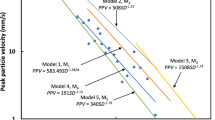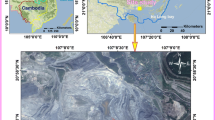Abstract
Blasting is a widely used technique for rock fragmentation in surface mines and tunneling projects. The ground vibrations produced by blasting operations are the main concern for the industries undertaking blasting operations, which can damage the surrounding structures, adjacent rock masses, roads and slopes in the vicinity. Therefore, proper prediction of blast-induced ground vibrations is essential to demarcate the safety area of blasting. In this research, classification and regression tree (CART) as a rule-based method was used to predict the peak particle velocity through a database comprising of 51 datasets with results of maximum charge per delay and distance from the blast face were fixed as model inputs. For comparison, the empirical and multiple regression (MR) models were also applied and proposed for peak particle velocity prediction. Performance of the proposed models were compared and evaluated using three statistical criteria, namely coefficient of correlation (R 2), root mean square error (RMSE) and variance account for (VAF). Comparison of the obtained results demonstrated that the CART technique is more reliable for predicting the peak particle velocity than the MR and empirical models and it can be introduced as a new technique in this field.






Similar content being viewed by others
References
Khandelwal M, Singh TN (2006) Prediction of blast induced ground vibrations and frequency in opencast mine: a neural network approach. J Sound Vib 289:711–725
Monjezi M, Ahmadi M, Sheikhan A, Bahrami M, Salimi AR (2010) Predicting blast-induced ground vibration using various types of neural networks. Soil Dyn Earthq Eng 30:1233–1236
Ebrahimi E, Monjezi M, Khalesi MR, Jahed Armaghani D (2015) Prediction and optimization of back-break and rock fragmentation using an artificial neural network and a bee colony algorithm. Bull Eng Geol Environ. doi:10.1007/s10064-015-0720-2
Jahed Armaghani D, Hasanipanah M, Mohamad ET (2015) A combination of the ICA-ANN model to predict air overpressure resulting from blasting. Eng Comput. doi:10.1007/s00366-015-0408-z
Saghatforoush A, Monjezi M, Faradonbeh RS, Jahed Armaghani D (2015) Combination of neural network and ant colony optimization algorithms for prediction and optimization of flyrock and back-break induced by blasting. Eng Comput. doi:10.1007/s00366-015-0415-0
Singh TN, Singh V (2005) An intelligent approach to prediction and control ground vibration in mines. Geotech Geolog Eng 23:249–262
Ozer U, Kahriman A, Aksoy M, Adiguzel D, Karadogan A (2008) The analysis of ground vibrations induced by bench blasting at Akyol quarry and practical blasting charts. Environ Geol 54:737–743
Verma AK, Singh TN (2011) Intelligent systems for ground vibration measurement: a comparative study. Eng Comput 27:225–233
Faramarzi F, Ebrahimi Farsangi MA, Mansouri H (2014) Simultaneous investigation of blast induced ground vibration and airblast effects on safety level of structures and human in surface blasting. Int J Min Sci Technol 24(5):663–669
Dindarloo SR (2015) Prediction of blast-induced ground vibrations via genetic programming. Int J Min Sci Technol 25(6):1011–1015
Bureau of Indian Standard (1973) Criteria for safety and design of structures subjected to underground blast. ISI Bull IS-6922
Kahriman A (2002) Analysis of ground vibrations caused by bench blasting at can open-pit lignite mine in Turkey. Environ Earth Sci 41:653–661
Singh TN (2004) Artificial neural network approach for prediction and control of ground vibrations in mines. Min Technol 113(4):251–256
Sawmliana C, Roy PP, Singh RK, Singh TN (2007) Blast induced air overpressure and its prediction using artificial neural network. Min Technol 116(2):41–48
Duvall WI, Petkof B (1959) Spherical propagation of explosion of generated strain pulses in rocks. USBM, RI-5483
Langefors U, Kihlstrom B (1963) The modern technique of rock blasting. Wiley, New York
Davies B, Farmer IW, Attewell PB (1964) Ground vibrations from shallow sub-surface blasts. Engineer 217:553–559
Ambraseys NR, Hendron AJ (1968) Dynamic behavior of rock masses: rock mechanics in engineering practices. Wiley, London
Roy PP (1993) Putting ground vibration predictors into practice. Colliery Guard 241:63–67
Verma AK, Singh TN (2013) A neuro-fuzzy approach for prediction of longitudinal wave velocity. Neural Comput Appl 22(7–8):1685–1693
Hudaverdi T (2012) Application of multivariate analysis for prediction of blast-induced ground vibrations. Soil Dyn Earthq Eng 43:300–308
Khandelwal M, Singh TN (2009) Prediction of blasting induced ground vibration using artificial neural network. Int J Rock Mech Min Sci 46:1214–1222
Hajihassani M, Jahed Armaghani D, Marto A, Tonnizam Mohamad E (2015) Ground vibration prediction in quarry blasting through an artificial neural network optimized by imperialist competitive algorithm. Bull Eng Geol Environ 74:873–886
Mohamed MT (2011) Performance of fuzzy logic and artificial neural network in prediction of ground and air vibrations. Int J Rock Mech Min Sci 48:845–851
Monjezi M, Dehghani H (2008) Evaluation of effect of blasting pattern parameters on back break using neural networks. Int J Rock Mech Min Sci 45:1446–1453
Monjezi M, Ghafurikalajahi M, Bahrami A (2011) Prediction of blast induced ground vibration using artificial neural networks. Tunn Undergr Space Technol 26:46–50
Iphar M, Yavuz M, Ak H (2008) Prediction of ground vibrations resulting from the blasting operations in an open-pit mine by adaptive neurofuzzy inference system. Environ Geol 56:97–107
Jahed Armaghani D, Momeni E, Abad SVANK, Khandelwal M (2015) Feasibility of ANFIS model for prediction of ground vibrations resulting from quarry blasting. Environ Earth Sci 74:2845–2860
Fisne A, Kuzu C, Hüdaverdi T (2011) Prediction of environmental impacts of quarry blasting operation using fuzzy logic. Environ Monit Assess 174:461–470
Ghasemi E, Ataei M, Hashemolhosseini H (2013) Development of a fuzzy model for predicting ground vibration caused by rock blasting in surface mining. J Vib Control 19(5):755–770
Hasanipanah M, Monjezi M, Shahnazar A, Jahed Armaghani D, Farazmand A (2015) Feasibility of indirect determination of blast induced ground vibration based on support vector machine. Measurement 75:289–297
Dindarloo SR (2015) Peak particle velocity prediction using support vector machines: a surface blasting case study. J South Afr Inst Min Metall 115(7):637–643
Hajihassani M, Jahed Armaghani D, Monjezi M, Mohamad ET, Marto A (2015) Blast-induced air and ground vibration prediction: a particle swarm optimization-based artificial neural network approach. Environ Earth Sci 74:2799–2817
Liang M, Mohamad ET, Faradonbeh RS, Armaghani DJ, Ghoraba S (2016) Rock strength assessment based on regression tree technique. Eng Comput. doi:10.1007/s00366-015-0429-7
Tiryaki B (2008) Predicting intact rock strength for mechanical excavation using multivariate statistics, artificial neural networks, and regression trees. Eng Geol 99:51–60
Tiryaki B (2009) Estimating rock cuttability using regression trees and artificial neural networks. Rock Mech Rock Eng 42:939–946
Henderson BL, Bui EN, Moran CJ, Simon DAP (2005) Australia-wide predictions of soil properties using decision trees. Geoderma 124(3):383–398
Gandomi AH, Fridline MM, Roke DA (2013) Decision tree approach for soil liquefaction assessment. Sci World J 2013:346285
Myles AJ, Feudale RN, Liu Y, Woody NA, Brown SD (2004) An introduction to decision tree modeling. J Chemom 18:275–285
Chou JS (2012) Comparison of multilabel classification models to forecast project dispute resolutions. Expert Syst 39:10202–10211
Pradhan B (2013) A comparative study on the predictive ability of the decision tree, support vector machine and neuro-fuzzy models in landslide susceptibility mapping. Comput Geosci 51:350–365
Michael JA, Gordon SL (1997) Data mining technique: for marketing, sales and customer support. Wiley, New York
Loh WY, Shih YS (1997) Split selection methods for classification trees. Stat Sin 7:815–840
Breiman L, Friedman J, Olshen R, Stone CJ (1984) Classification and regression trees. Wadsworth, Belmont
Quinlan JR (1986) Introduction of decision trees. Mach Learn 1:81–106
Biggs D, Ville BD, Suen E (1991) A method of choosing multiway partitions for classification and decision trees. J Appl Stat 18:49–62
Quinlan JR (1993) C4.5: programs for machine learning. Morgan Kaufmann, San Mateo
Nelson M, Illingworth WT (1990) A practical guide to neural nets. Addison-Wesley, Reading
Shams S, Monjezi M, Majd VJ, Armaghani DJ (2015) Application of fuzzy inference system for prediction of rock fragmentation induced by blasting. Arab J Geosci 8(12):10819–10832
Jahed Armaghani D, Mohamad ET, Hajihassani M, Yagiz S, Motaghedi H (2015) Application of several non-linear prediction tools for estimating uniaxial compressive strength of granitic rocks and comparison of their performances. Eng Comput. doi:10.1007/s00366-015-0410-5
Jahed Armaghani D, Mohamad ET, Momeni E, Monjezi M, Narayanasamy MS (2016) Prediction of the strength and elasticity modulus of granite through an expert artificial neural network. Arab J Geosci. doi:10.1007/s12517-015-2057-3
Inc SPSS (2007) SPSS for windows (Version 160). SPSS Inc, Chicago
Author information
Authors and Affiliations
Corresponding author
Rights and permissions
About this article
Cite this article
Khandelwal, M., Armaghani, D.J., Faradonbeh, R.S. et al. Classification and regression tree technique in estimating peak particle velocity caused by blasting. Engineering with Computers 33, 45–53 (2017). https://doi.org/10.1007/s00366-016-0455-0
Received:
Accepted:
Published:
Issue Date:
DOI: https://doi.org/10.1007/s00366-016-0455-0




